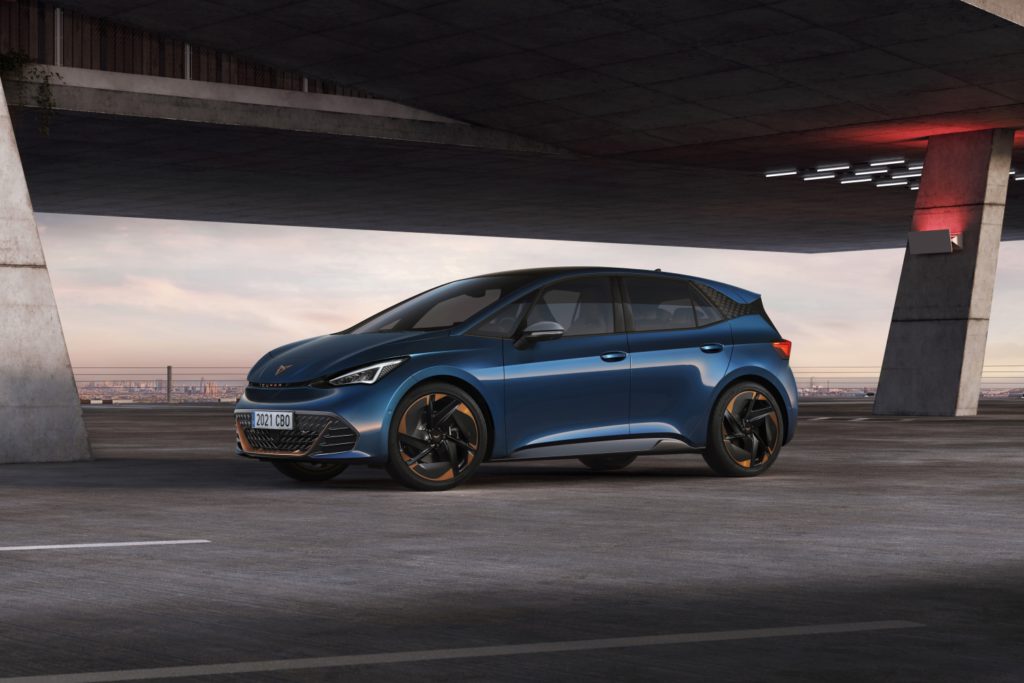Does star quality shine through for the new Mercedes-Benz EQB?
08 March 2022
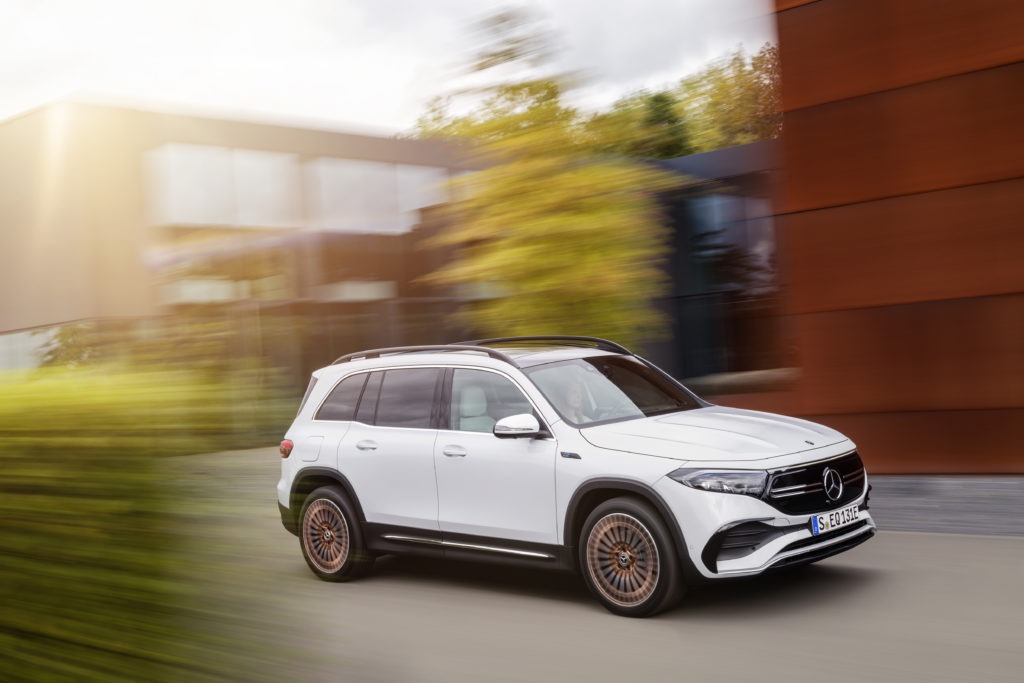
In a new Autovista24 series, principal analyst Sonja Nehls digs into how new cars rate at launch and what remarketing potential they hold. The first vehicle up for examination: the Mercedes-Benz EQB.
Typically, new Mercedes-Benz models can rely on strong residual values (RVs) in the used-car market. The below industry-standard battery size, charging technology along with some major gaps in standard equipment mean the EQB does not claim the pole position in the race for strong car-remarketing potential.
There are pitfalls to watch out for, along with ways to improve the individual RV of each EQB model purchased, leased or added to a fleet.
As a new car, the Mercedes-Benz EQB is an appealing battery-electric vehicle (BEV) for families or those who simply need that little bit of extra room, with its spacious design and versatile interior. It is a true Mercedes-Benz in terms of refinement, drive comfort, great material selection and style, along with the state-of-the-art user experience MBUX and Electric Intelligence navigation.
We can assume that at least 50% of all new EQBs sold will reach the used-car market within three years, mainly as off-lease vehicles. EV-volumes.com forecasts a sales volume of 62,425 units in Europe between 2022 and 2026. Calculations using an average sale price of €60,000 and an RV of roughly 48%, show the annual remarketing volume will be up to €250 million. This and the current dynamics of the automotive industry, especially for electric cars, emphasise the importance of forward-looking and resilient remarketing risk management.
Mercedes-Benz EQB’s remarketing potential
| Remarketing upsides | Remarketing downsides |
| Roominess and versatility | Small battery, high consumption and slow charging capability |
| Material selection, drive comfort and MBUX Electric Intelligence | Gaps in standard equipment and expensive option line-up |
| Heatpump as standard | BEV RVs are under pressure and will see downward corrections in 2022/23 |
Since the introduction of the first B-Class in 2005, the letter B in Mercedes-Benz model names promises family suitability and space. The EQB does deliver on that promise.
A more bulky and upright silhouette differentiates it from the EQA and EQC. Where these two siblings have roominess and practicality shortcomings because of their more coupé-like silhouettes, the EQB does not. It offers space and versatility, as well as a seven-seat option, only matched by the Tesla Model Y. In the French car market where seven-seaters are traditionally popular, Mercedes-Benz even made it the standard configuration.
The EQB has the same side-view and wheelbase as its internal-combustion engine (ICE) equivalent, the GLB. The front and rear of the car look more elegant and clean than on the GLB and the light-band connecting the headlights in combination with the closed EQ panel lends a contemporary look to the EQB. While some potential customers will miss a more differentiated BEV-look, others will choose the EQB exactly for that reason.
The main competitors in the electric-car compact SUV segment are the Audi Q4 e-tron, the BMW iX3 and the Tesla Model Y, while the Hyundai Ioniq 5 and Skoda Enyaq should not be ignored. With its forementioned shape, the EQB more closely compares to the iX3 or Enyaq than it does to the Model Y or Ioniq 5. The Volvo XC40 also comes to mind in terms of style, but being 26cm shorter than the EQB, it sits in another segment.
Specifications and dimensions vs. main rivals

Source: Autovista Group specification data
With a height of 1.67m, the Mercedes-Benz EQB is the tallest among its rivals, in line with the iX3. The BMW and Tesla are up to 7cm longer, whereas the Volkswagen (VW) Group vehicles – Q4 and Enyaq – are lower and have a shorter wheelbase.
The car’s top speed is limited to 160 kph, whereas most competitors allow for 180 kph or more. While this looks less appealing on paper, it will not matter much in real life as BEVs typically excite with acceleration, not top speed. Only a few German Autobahn lovers will miss being able to go faster every now and then.
The EQB does not have any towing capacity, unlike its rivals. Not a major issue, but still an inconvenience in a family car of this size.
BEV specifications below industry standards
The sheer numbers do not put the Mercedes-Benz EQB in a good competitive situation when it comes to BEV specifications. It has the smallest battery, high energy consumption and slow DC-charging capability.
It is surprising to see that the BEV does not feature a better charging technology. The maximum of 100kW DC-charging capacity compares poorly against the 125kW and 150kW for the Audi and BMW respectively and falls way behind Tesla’s 250kW and Hyundai’s 220kW.
BEV specifications vs. main rivals

Source: EV-volumes.com
One can certainly argue that 100kW is sufficient when charging in everyday life. Many stations do not allow for faster charging anyway and depending on the temperature and state of charge, EQB drivers can get around 150km of driving range within 15 minutes. Also, its Electric Intelligence navigation, with optimised planning for charging stops, is an asset and outperforms competitors’ systems.
So why does the low charging capacity still pose a remarketing risk? The segment standard is already higher and thinking three years ahead to the point of remarketing, this deficit will be noticed and assessed not only in comparison to the other vehicles on the used-car market, but to the industry standard at that time. Charging anxiety has become the new range anxiety and the speed of charging is an important signpost for customers.
Building a remarketing-optimised EQB
The main market for the Mercedes-Benz EQB will be Germany, in terms of total volumes, but also when considering the relative importance of the model and its market share. I turned to the German car configurator to build my own, remarketing-optimised version of the EQB. This means fitting reasonable equipment, not missing any must-haves or highly-demanded features that match the expectations of buyers on the used-car market.
Using these metrics, my EQB becomes one of the most expensive of the pack, with 18% of its list price added through optional equipment. What did surprise me a little was that the BMW iX3, in contrast, only adds options worth €1,130 and is only €50 more expensive than the EQB, despite starting with a 16% list-price premium.
This is a prime example of why it is important to look not only at the list price but also at the standard equipment on offer. Gaps in standard equipment, alongside a complex and pricey option line-up, can result in important features missing from a used car, which leaves models with lower remarketing potential.
While increasing the absolute RV in Euros, extensive optional equipment typically decreases the relative %RV of a model. In my example, the %RV of the EQB drops by up to 2.5pp after it is reasonably equipped.
For the sake of a better comparison to its rivals, I selected the EQB 350 4MATIC – this is the version with the highest engine output of 215kW (292hp). Due to the iX3 only being available in a 210kW (286hp) version and the Tesla with its 378kW (514hp) output, comparing against any other variant would have been too distorted.
I assume that the lower-powered EQB 250 and EQB 300 4MATIC will have a higher share with fleet customers throughout Europe, as they are more affordable and efficient in real life. The Q4 e-tron, Ioniq 5 and Enyaq are all available with a lower engine output to compare well against the EQB 250 or EQB 300 4MATIC. In any case, the overall findings from this detailed equipment comparison will also largely transfer to the other versions.
Mercedes-Benz specifically speaks of having simplified the offer logic for the compact Mercedes EQ models. However, a field trip to the model configurator left me with a slightly different experience.
The offer logic remains complex and it can take a while to navigate different design lines (Progressive, Electric Art, AMG Line), the additional option of the Night package and the launch version Edition 1. As the lines focus almost exclusively on design differentiation, I chose the Progressive line, which is the basic version. The EQB 350 4Matic Progressive starts at €57,988, roughly in line with the Tesla Model Y.
Choosing one of the equipment packages, either the Advanced or the Advanced-Plus pack is prudent – or better, necessary – to close some of the gaps in standard equipment. The Advanced pack adds the customizable 10.25-inch fully-digital instrument cluster and the 10.25-inch media display. Without it, the EQB lacks a lot of its interior appeal.
The pack also includes parking assist with a rear-view camera. I selected the Advanced-Plus pack as I did not want to miss out on two-zone climate control, keyless entry and wireless charging in my remarketing-optimised EQB. The extended driver-assistance systems are combined in one pack as well and can be added at €1,439. Without this pack, the EQB would feature a speed limiter and lane departure warning, but no cruise control, blind-spot detection or other advanced driver-assistance systems (ADAS).
Remarketing-optimised configuration comparison

Source: OEM configurators
Note: S= standard equipment, prices given refer to cost of a pack or single option
The versatility and roominess of the EQB are among its major strengths. However, buyers have to decide in advance what kind of versatility they prefer, as they can only go for either the slideable rear bench or a seven-seat configuration, not both.
Besides the considerable gaps identified in the EQB’s standard equipment, there are some noteworthy strengths.
The upside
The heat pump is always standard and allows for more efficient and energy-saving heating of the cabin. The head-up display (HUD) features augmented-reality information, like direction arrows, and ensures that the driver can keep their eyes on the street.
I wondered whether I should leave out the expensive option of the head-up display, as Tesla does not offer one. On the otherwise brilliantly equipped iX3, it is only available in the higher and more expensive trim. I finally decided to keep it in and spend the extra €1,369 for this useful, modern and cool extra, which will certainly meet rising demand from future used-car buyers.
Fleet cars and leasing models should ideally be equipped with at least the Advanced pack and the driver-assistance pack to meet future used-car buyers’ expectations. Even then, popular features such as heated seats or the smartphone integration via Apple CarPlay or Android Auto could easily be missed and need to be added as single options.
Mercedes-Benz simplifies its offer logic somewhat by offering functional packages. All information is easy to find and well explained, but it remains complex and customers have to take many individual decisions.
Tesla is the complete opposite and customers may struggle with the simplicity of the offerings and finding more info about what is included in standard equipment and what is not.
The BMW iX3 surprises with a simplistic and transparent offer logic featuring two functional trim lines, very unlike its past approach. The Inspiring trim line, which is also the entry version, comes at a high price but also with comprehensive standard equipment. It will be impossible to encounter an iX3 on the used-car market that lacks a very relevant feature, apart perhaps from the HUD.
Equipment-difference obstacles for cross-border remarketing
While Germany is examined in-depth as a lead market, it is worth looking into the offer logic elsewhere in Europe. In France, Mercedes-Benz offers a business line on the EQB 250, which already includes features like metallic paint and the Advantage/Advanced pack. By doing so, it not only ensures that these cars always have an appropriate level of standard equipment, but also that the RV reflects this correctly.
In the UK another approach has been taken. In this market, only the AMG Line version is available. It includes 19-inch wheels and the full Advanced Plus pack. The configuration process is very simple and in terms of options, it is really just a question as to whether to go for the extended driving assistance package or not. All EQBs in the UK used-car market will feature comprehensive standard equipment in any case.
The major differences between the countries add complexity and create obstacles for potential cross-border remarketing. This not only refers to whether a package is standard or not, but also to some countries such as Italy, having a completely different pack structure.
BEV RVs under pressure
Mercedes-Benz models share an outstanding RV performance across segments and markets, and the Autovista Group OEM RV performance index sees Mercedes-Benz at an index of 112 in Germany and up to 122 in Italy.
Mercedes-Benz OEM RV performance index
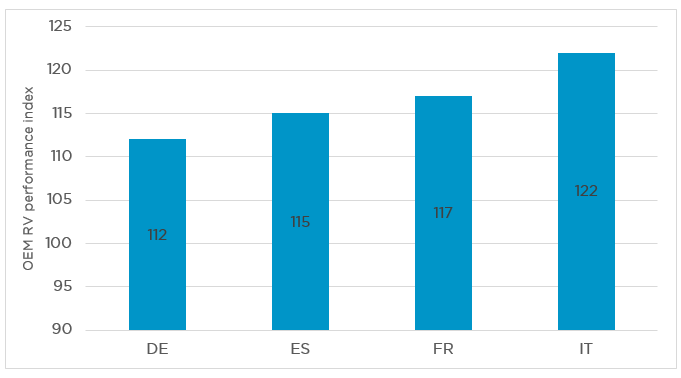
Source: Autovista Group OEM RV performance index, February 2022
This index refers to a weighted comparison of residual values of each model within its segment and an overarching average for the brand taking into account all the segments an OEM is represented in. The OEM RV performance index therefore encompasses all aspects driving a strong remarketing potential, from quality and reliability, to established business customer co-operations and after-sales service. It indicates a general remarketing outlook for all models of an OEM. That outlook is clearly positive for the EQB as a Mercedes-Benz model.
RVs for BEVs in the D-SUV segment have performed on a fairly stable level throughout 2021 and did not participate in the RV surge, which was almost completely driven by the demand for ICEs. The UK is a bit of an exception. It did experience rising RVs for BEVs in 2021, but to a much lesser extent than what the overall market achieved.
Trade RV and list price development in the BEV D-SUV segment (36 months / 60,000km)
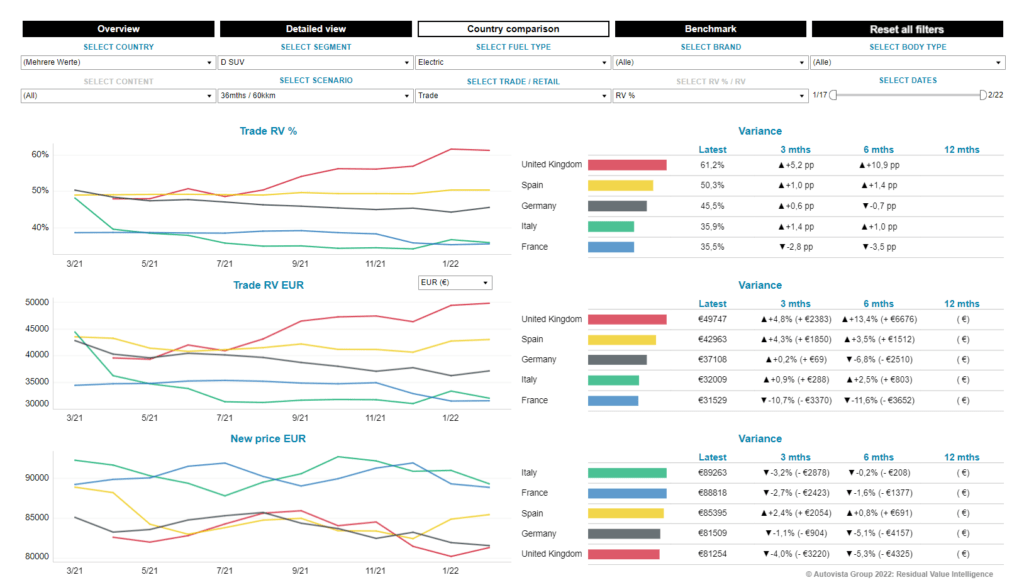
Source: Autovista Group Residual Value Intelligence
In France, an expected downwards correction for BEVs started in 2021. For 2022 and 2023 further corrections are expected.
RV Outlook 2022-23 for the BEV D-SUV-segment

Source: Autovista Group Residual Value Intelligence
In line with the electric D-SUV segment’s differing RV level across the big five European countries, the EQB’s %RVs range between 43.4% in France and 59.1% in the UK. The EQB 250 has only been recently added to the line-up and RVs are not included for those variants yet. The dashboard will be updated to include the EQB 250 and other missing versions.
Mercedes-Benz EQB RV forecast, 36mth/60kkm, Feb 2022
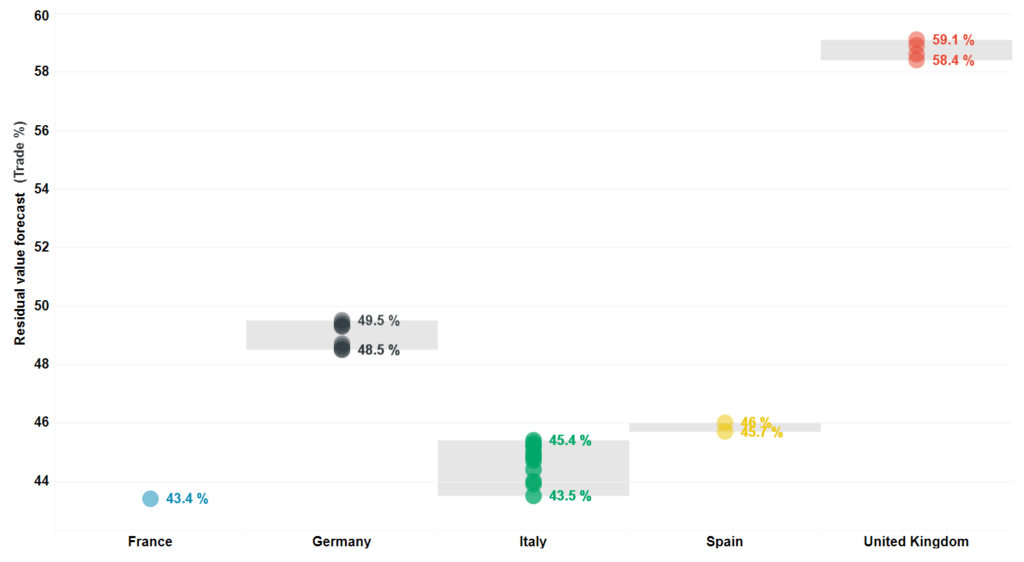
Source: Autovista Group
Due to the major equipment and line-up differences between countries, the €RV ranges are also massive. In Italy, the entry version starts at €25,275 after three years and 60,000km and goes up to a more or less fully-equipped EQB 350 4MATIC AMG Line Premium at £32,912 (€39,897) in the UK. The varying offer logic is reflected in the number of dots representing the different variants of the EQB.
Mercedes-Benz EQB RV forecast vs competitors, Germany, 36mth/60kkm, Feb 2022
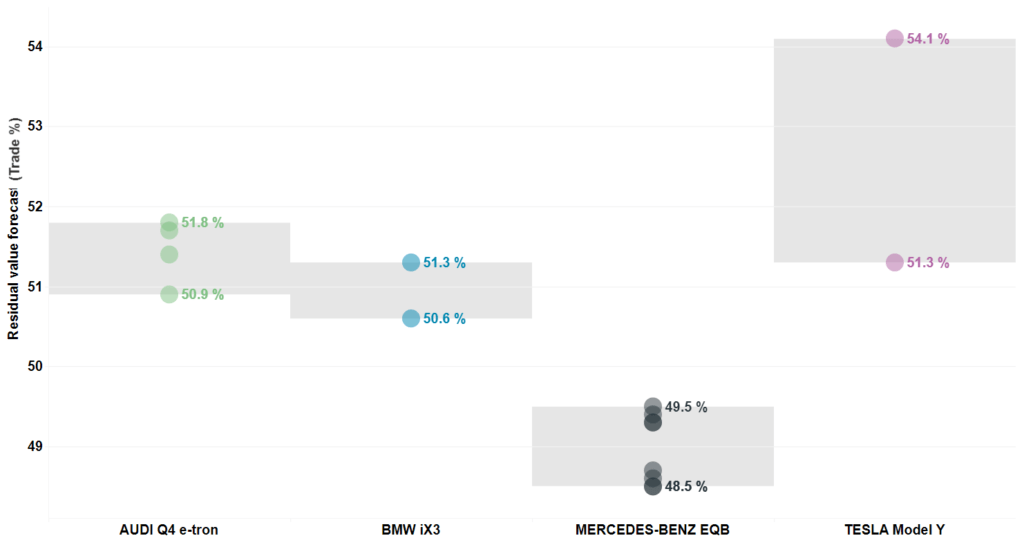
Source: Autovista Group
When putting the spotlight on the lead market, Germany, and comparing it with the main rivals, we see the %RVs for the EQB being the lowest, despite the typically strong RV performance of Mercedes-Benz models. The Tesla Model Y and BMW clearly perform better, which is a direct result of the comparatively high list price of the EQB in combination with its sub-par BEV specifications and the gaps in standard equipment. Actual RVs for reasonably equipped EQBs will even be up to 2.5pp lower.
So does the Mercedes-Benz star quality shine through for the EQB? It does, as the EQB lives and breathes the brand and the exterior and interior style and execution leave no doubt about this. Yet there is still room for improvement. Competitors have stronger arguments when it comes to charging solutions and offer complexity. So the rose-gold keyframe and applications on the dashboard remain the only gold for the EQB for now, but there is no way I could resist mentioning how much I love those features.



